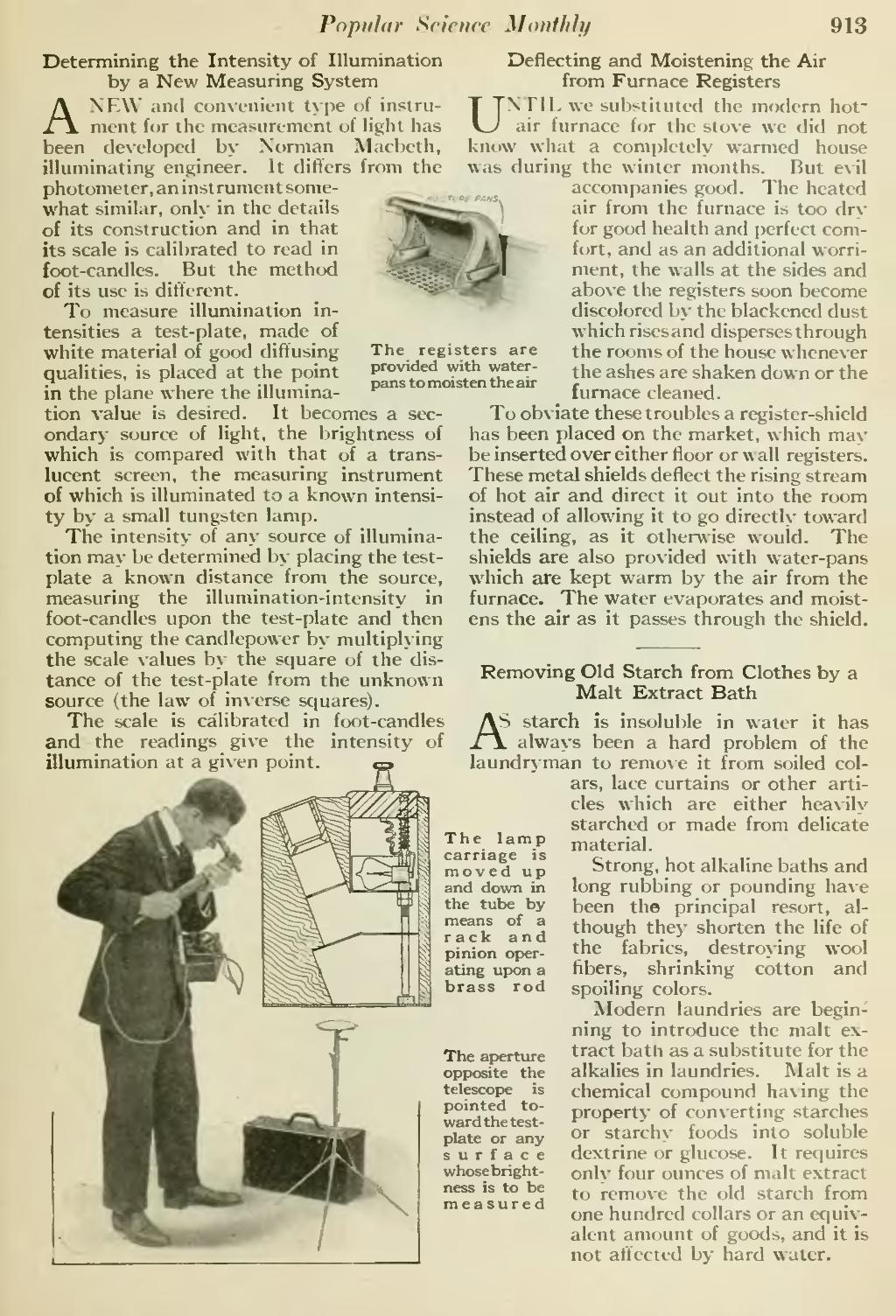Popular Science Monthly
��913
��Determining the Intensity of Illumination by a New Measuring System
ANEW and cun\eniont type of instru- ment for the measurement of light lias been developed by Norman Macbeth, illuminating engineer. It differs from the photometer, an instrument some- what similar, only in the details of its construction and in that its scale is calibrated to read in foot-candles. But the method of its use is ditYerent.
To measure illumination in- tensities a test-plate, made of white material of good diffusing qualities, is placed at the point in the plane where the illumina- tion value is desired. It becomes a sec- ondary source of light, the brightness of which is compared with that of a trans- lucent screen, the measuring instrument of which is illuminated to a known intensi- ty by a small tungsten lamp.
The intensity of any source of illumina- tion may be determined by placing the test- plate a known distance from the source, measuring the illumination-intensity in foot-candles upon the test-plate and then computing the candlepower by multiplying the scale values by the square of the dis- tance of the test-plate from the unknown source (the law of inverse squares).
The scale is calibrated in foot-candles and the readings give the intensity of illumination at a given point.
���The registers are provided with water- pans to moisten the air
��Deflecting and Moistening the Air from Furnace Registers
UNTIL wc substituted the modern hot" air furnace for the stove we did not know what a completely warmed house was during the winter months. But evil accompanies good. The heated air from the furnace is too dry for good health and perfect com- fort, and as an additional worri- ment, the walls at the sides and above the registers soon become discolored by the blackened dust which riscsand disperses through the rooms of the house whenever the ashes are shaken down or the furnace cleaned. To obviate these troubles a register-shield has been placed on the market, which may be inserted over either floor or wall registers. These metal shields deflect the rising stream of hot air and direct it out into the room instead of allowing it to go directly toward the ceiling, as it otherwise would. The shields are also provided with water-pans which are kept warm by the air from the furnace. The water evaporates and moist- ens the air as it passes through the shield.
��A^
���Removing Old Starch from Clothes by a Malt Extract Bath
S starch is insoluble in water it has always been a hard problem of the laundrjman to remo\e it from soiled col- ars, lace curtains or other arti- cles which are either heavily starched or made from delicate material.
Strong, hot alkaline baths and long rubbing or pounding have been the principal resort, al- though they shorten the life of the fabrics, destroying wool fibers, shrinking cotton and spoiling colors.
Modern laundries are begin- ning to introduce the malt ex- tract bath as a substitute for the alkalies in laundries. Malt is a chemical compound ha\ing the property of converting starches or starchy foods into soluble dextrine or glucose. It requires only four ounces of malt extract to remove the old starch from one hundred collars or an equiv- alent amount of goods, and it is not aftected by hard water.
��The lamp carriage is moved up and down in the tube by means of a rack and pinion oper- ating upon a brass rod
��The aperture opposite the telescope is pointed to- ward the test- plate or any surface whose bright- ness is to be measured
�� �

